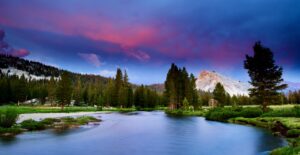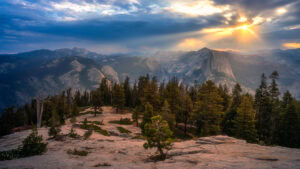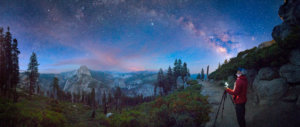Hiking options are endless at Yosemite! Whether you are going for a leisurely stroll to May Lake or full day saunter up the Mist Trail or taking on Half Dome, here is the must have packing list for the perfect Yosemite day hike!
1. Layers
Be prepared for potential temperature shifts anywhere in Yosemite, but especially when hiking at higher elevations. Even in the peak of summer you may encounter afternoon thunderstorms. The average temperature in Yosemite in summer is 89˚F (32˚C) during the day but can quickly drop. Be sure that you have breathable layers, including a waterproof lightweight jacket, a mid-layer long sleeve shirt for both sun coverage and warmth, and a baselayer such as a tank or t-shirt for when it gets hot. Opt for sports fabric over cotton. Jeans or denim of any sort are not recommended. It’s too heavy for hiking and it doesn’t breathe very well. Also don’t forget a hat and sunglasses.
Lastly, always keep a plastic poncho in your day pack for emergency thunderstorms or walking by a misty waterfall. You probably won’t need it, but they weigh almost nothing and can really help keep you comfortable in unexpected weather.
2. Good hiking shoes and socks
Good hiking shoes mean different things to different people. Some people prefer a heavy-duty, high-ankle support boot and others opt for a lightweight waterproof hiking sandal, it’s a matter of preference but definitely make sure it is well-worn to avoid blisters. Thick hiking socks can also provide a good cushion and keep your feet warm.
3. Water (and plenty of it)
The importance of having enough water cannot be overstated. A minimum of three quarts/liters of water per day is recommended and more if you are going to be on a trail with little shade or with a lot of elevation gain (ie: uphill!). That can be a lot to carry so the best idea for long day hikes is to bring a system for purifying your water. You can purify your water with iodine tablets, a water filtration pump or a water bottle with a water filtration system built in. Lifestraw offers one of these types of bottles and it works very well for conveniently filling your water bottle from streams and creeks along the trail. Never drink unfiltered water in Yosemite. When treating or filtering water always select sources where the water is running and appears clear. Most trails have water available but you should always do a little research to be sure.
4. Snacks
Whether your favorite trail fix is good old GORP (granola, oats, raisins, peanuts), chewy jerky, Kind or Cliff Bars, or some other tasty treat, snacks are a must on the trail. A 160-lb person burns between 430 and 440 calories per hour! Holy granola, that’s a lot of GORP! Even if you are going for a short hike make sure you take a few snacks with you. If you are hiking for several hours you may want to consider something more substantial. Some of our favorite places for getting a pre-packed lunch for Yosemite trails are listed below:
Degnan’s Deli in Yosemite Valley
High Country Health Foods and Café in Mariposa
June Bug Café in Midpines (for early morning pick up call in an order the evening before and pick up on your way the park)
Jantz Bakery in Mariposa
Or make your own! Our favorite trail meal includes packing all the elements separately: bread, protein and veggies each in their own packet – then assembling it on the trail. Hummus and mustard works better than mayonnaise unless it comes in a no refrigeration-needed package. Great sides include a bag of chips and apples. And heck, you’ve burned so many calories, why not throw in a cookie! Be sure to take a plastic bag with you to pack up your trash after you are done.
5. Sun Protection & Bug Spray
The tell-tell sign of a poor planner at the end of the day is the hiker covered in bug bites sporting lobster-red skin! Don’t let this be you. Make sure you pack sunscreen (and the trick is to apply it often) and plan to encounter the most legendary of Yosemite wildlife – mosquitos!
6. In Case of Emergency
Hope for the best, but plan for the unexpected. We listed some additional items below which are a really good idea if you plan on taking any hike that’s longer than a couple of miles:
- Headlamp: In case you decide you want to hang out at the perfect vista until sunset or your hike takes longer than planned, you will want to keep a headlamp handy for helping you find your way back to the trail head.
- First Aid Kit: You can easily purchase a pre-package kit or make your own by taking an assortment of bandaids, some antiseptic cream or alcohol wipes, aspirin, moleskin for blisters, and gauze pads.
- Whistle: If you get separated from your fellow hikers or take a fall from the trail a whistle can help others find you.
- Tissues and Hand Sanitizer: In case a bathroom break is needed on the trail it’s a good idea to have a small pack of tissues, a plastic bag (for packing out your tissue) and hand sanitizer. Or even if you plan to visit one the pit toilets in the park you will want hand sanitizer and they may not always be well-stocked with TP. Plan ahead to avoid inconvenience. Do your business 100 yards from any water. If you plan to go au natural, bring your tissue out with you, don’t leave it in the park for the next hiker to find!
More Hiking Advice
- If you plan on hiking alone be sure you leave a note at your hotel and let a family member or friend know where you plan to be and when you will be back. Definitely take a whistle.
- Water in Yosemite is notoriously swift. Do not let young children play near moving water unattended. Do not enter the water immediately above or immediately below a waterfall. You cannot judge the swift current moving below a smooth surface.
- Stay behind all barriers and pay attention to notices posted.
- Do not approach or feed wildlife. Yosemite’s animals have plenty of healthy food to eat naturally and our food is toxic to their health. Keep all of your food within reach at all times.
- Do not leave your trash behind.
What not to bring
- Bear spray or bear deterrent devices or chemicals. Yosemite black bears are not inherently aggressive towards humans and will generally try to avoid you as much as you attempt to avoid them. Bear spray, firearms, horns, etc. are not necessary and may be illegal to carry in Yosemite National Park. Check regulations here.
- Liquid detergent hand or cleaning soap(s). Normal household detergents contain many chemicals that can be detrimental to the ecosystem of Yosemite National Park. Never to directly wash or clean with any soaps regardless of manufacture directly into streams or rivers. The foaming ingredient of most soaps can easily kill or harm local fish and aquatic species of animals.




